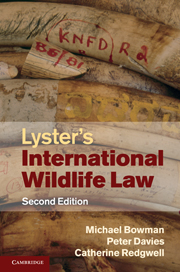Book contents
- Frontmatter
- Contents
- Foreword
- Preface
- List of abbreviations
- PART I Foundations of international wildlife law
- 1 The historical evolution of international wildlife law
- 2 Wildlife and the international legal system
- 3 The philosophical foundations of international wildlife law
- 4 Implementation and enforcement of international wildlife law
- PART II Species regulation
- PART III Regional wildlife regulation
- PART IV Global wildlife regulation
- PART V Biological diversity: a new perspective on wildlife regulation
- PART VI Cross-sectoral issues in wildlife regulation
- PART VII Conclusion
- Index
- References
2 - Wildlife and the international legal system
Published online by Cambridge University Press: 05 July 2011
- Frontmatter
- Contents
- Foreword
- Preface
- List of abbreviations
- PART I Foundations of international wildlife law
- 1 The historical evolution of international wildlife law
- 2 Wildlife and the international legal system
- 3 The philosophical foundations of international wildlife law
- 4 Implementation and enforcement of international wildlife law
- PART II Species regulation
- PART III Regional wildlife regulation
- PART IV Global wildlife regulation
- PART V Biological diversity: a new perspective on wildlife regulation
- PART VI Cross-sectoral issues in wildlife regulation
- PART VII Conclusion
- Index
- References
Summary
Introduction
Since this work focuses specifically upon the use of international legal measures for the conservation, management and protection of wildlife, it will be helpful to begin with a brief overview of the international legal system generally, contrasting it with other legal regimes. Public international law is the body of legal principles that governs states and other international persons in their dealings with one another on the international plane. Its scope extends far beyond the realms of environmental regulation to embrace peaceful co-operation and the conduct of diplomatic relations generally, prohibitions on the use of force in international affairs and the protection of human rights, to name but a few major areas of concern. This system is to be contrasted with the collection of norms – known variously as national, domestic or municipal law – that operates within each nation to regulate the activities of ordinary human beings and other entities (such as limited companies and public corporations) that are recognised as possessing rights and duties under the system in question. Public international law must also be distinguished from other supra-national systems, of which the most conspicuous current example is the law of the European Union – a regional inter-governmental organisation created by a succession of treaties which, while themselves governed by international law, have the effect of generating a distinct legal order, with its own institutions, law-making procedures and mechanisms for enforcement, which is applicable to and within member states.
- Type
- Chapter
- Information
- Lyster's International Wildlife Law , pp. 24 - 60Publisher: Cambridge University PressPrint publication year: 2010



